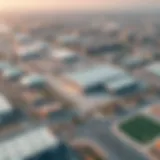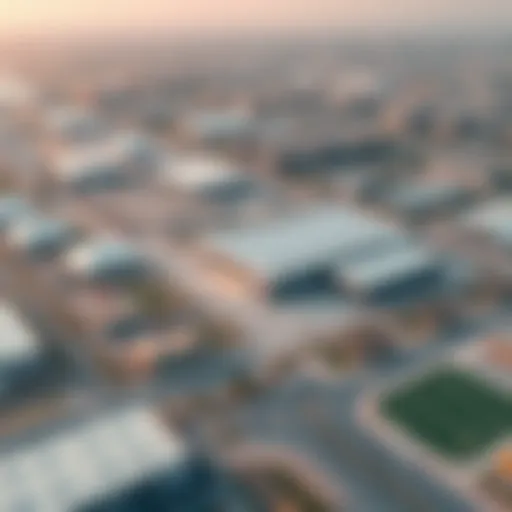Green Gardens in Dubai: Urban Oasis and Investment Insights
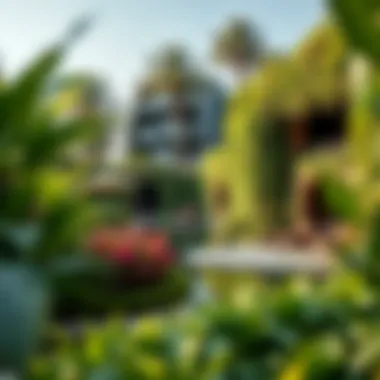
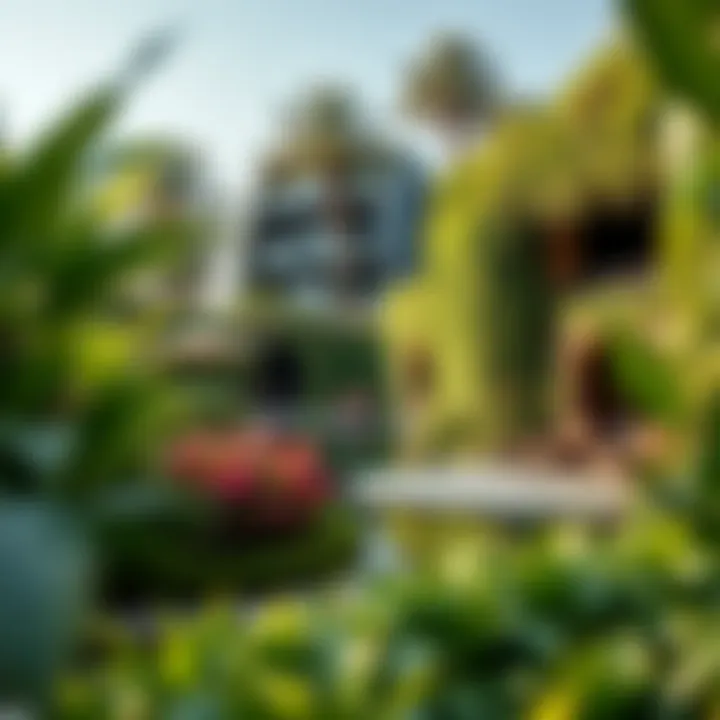
Intro
Dubai, a city known for its towering skyscrapers and bustling urban landscape, also harbors a vibrant pursuit of green spaces. As urbanization accelerates at an unrelenting pace, the value of lush greenery in bustling environments becomes more evident. Green gardens in this desert metropolis do more than provide aesthetic beauty; they establish a vital connection between nature and city life, playing a significant role in enhancing wellbeing, fostering community engagements, and elevating property worth. This article peels back the layers of Dubai’s green gardens, examining not just their physical presence but the heartbeat they offer to urban dwellers.
The rising tide of eco-consciousness has breathed new life into discussions around landscaping and garden spaces. In a city often defined by its desert climate, innovative initiatives have emerged, knit together with an overarching ambition to create sustainable urban living. Developing and maintaining green spaces poses unique challenges, from soil composition to climatic conditions. However, through creativity and resilience, Dubai is carving out a future where green gardens thrive amid its shimmering skyline.
Market Trends and Insights
The garden scene in Dubai reflects wider market dynamics, displaying both current trends and prospective insights for investors and homeowners alike. With a keen focus on urban greenery, the real estate market increasingly intertwines with landscaping innovations that cater to residents’ desires for a refreshing escape from everyday hustle.
Current Market Analysis
Real estate in Dubai has seen a notable upswing in properties associated with extensive landscapes and garden spaces. Premium listings with private gardens stand out significantly, providing both aesthetic appeal and an implied upgrade in lifestyle. A property with a well-maintained outdoor space can fetch a premium, adding value that resonates with buyers looking for tranquil retreats.
- The landscape architecture sector has adapted to cater to this demand. New developments often prioritize open spaces, parks, and community gardens.
- Gardens and green spaces are becoming selling points, especially for families and expatriates seeking a balanced lifestyle.
Greater emphasis is placed on properties that integrate eco-friendly practices. Techniques such as xeriscaping—landscaping that reduces the need for irrigation—are growing in popularity. This not only supports sustainability aspirations but also appeals to fiscal prudence by lowering maintenance costs for homeowners.
Historical Trends and Future Predictions
Looking back over the years, Dubai's green landscape has evolved from sparse patches of grass to expansive parks and botanical gardens. The shift reflects a broader acknowledgment within city planning of the benefits offered by green spaces. Key historical policies, aimed at enhancing urban livability, have set the stage for a greener future.
"The integration of sustainability into urban development is no longer optional; it's a mandate for future success."
As weather patterns shift and the realities of climate change take center stage, the future of green gardens may evolve further. Anticipating a greater demand for sustainable solutions, developers and investors must remain vigilant. Projects that emphasize ecological awareness, like bio-diverse gardens and eco-parks, are likely to dominate future developments.
Property Listings and Comparisons
The property market in Dubai presents various options to cater to diverse tastes and budgets. Buyers keen on green gardens have numerous listings to consider, ranging from luxury estates to budget-friendly homes.
Luxury Properties Overview
High-end properties featuring opulent gardens have captivated many buyers. Estates typically come equipped with spacious yards and exquisite landscaping options. Features often include:
- Custom water features that enhance serenity
- Native plant selections that are easier to maintain in Dubai's climate
- Outdoor living spaces, transforming yards into extensions of the home
Affordable Housing Options
For those with more modest budgets, Dubai does not fall short. Affordable developments are increasingly integrating green spaces, making these communities appealing to first-time buyers. Garden spaces in such homes might include:
- Shared community gardens where neighbors can grow their own herbs or flowers
- Parks offering recreational opportunities for residents without large backyards
- Pocket gardens that efficiently utilize small corners of property
In essence, green gardens not only elevate the aesthetic aspect but can also provide solutions for community building and residential satisfaction that are vital in today’s fast-paced urban lifestyle. As Dubai continues to evolve, so too will the role of these green sanctuaries within its property market.
Prelims to Green Gardens in Dubai
In a city well-known for its cutting-edge architecture and arid landscapes, the notion of green gardens serves as a symbol of sustainability and urban development. The emergence of green gardens in Dubai is not just about aesthetics; it speaks to a pressing need for urban interplay with nature. Amidst the rapid urbanization, such spaces offer a respite not only to the eye but also to the soul, enhancing the overall quality of life in this vibrant metropolis.
When we explore greenness in the heart of Dubai, it becomes imperative to understand its multifaceted significance. Green gardens serve as leisurely spots for families and tourists alike, acting as crucial lungs for the city amid the bustling atmosphere. They also provide a nurturing environment for flora and fauna that might otherwise struggle to thrive in the harsh climate. By promoting biodiversity, these gardens contribute to ecological balance, encouraging a vibrant urban ecosystem that benefits everyone.
Furthermore, the presence of these green spaces has tangible economic advantages that cannot be overlooked. Real estate investors are increasingly prioritizing properties that boast proximity to lush gardens, acknowledging that these areas often command higher market values. This is due, in part, to the enhanced lifestyle offerings, which make them desirable for potential homeowners.
With numerous sustainability initiatives gaining traction, the integration of greenery within urban settings reflects a larger commitment to environmental stewardship. As Dubai pushes its envelope of innovation, the transformation into a greener city resonates widely with both local and international audiences. The narrative henceforth dives into not only the worthy mentions of exquisite gardens but also the climatic challenges faced while establishing such verdant havens in a desert landscape.
The Importance of Greenery in Urban Settings
Urban growth is often accompanied by a wave of concrete and steel that can overshadow the essential presence of nature. Greenery in urban settings is not merely decorative; it has measurable health benefits, fostering mental well-being among city dwellers. Studies have indicated that closer proximity to green spaces reduces stress and promotes healthier lifestyles. Trees and plants aid in cleansing the air, trapping pollutants and providing a cooler environment, which directly benefits residents in Dubai’s hot climate.
Additionally, green gardens can improve community cohesion. When individuals gather in these common spaces, there’s an intrinsic opportunity for social interactions that strengthen bonds among neighbors. Community-oriented gardens often become gathering spots, nurturing friendships that might not arise in a solely urban environment. Hence, fostering these gardens can effectively enhance not only ecological conditions but also social dynamics within communities, fostering a sense of belonging.
Overview of Dubai's Unique Climate
Dubai’s climate presents a genuine challenge to those aspiring to cultivate green gardens. The harsh, arid conditions with soaring temperatures and minimal rainfall impose unique restrictions on plant choice and gardening methods. However, these challenges have sparked innovative solutions tailored to overcome the limitations imposed by the climate.
The summer heat can be unforgiving, regularly pushing temperatures above 40 degrees Celsius. Yet, understanding the climatic patterns allows gardeners to adapt their strategies. For instance, indigenous plant species, which naturally flourish in such environments, can be key players in establishing successful green spaces. Their hardiness aids in conserving water, a vital factor in Dubai. Moreover, advanced irrigation technologies such as drip systems optimize the use of water, making it possible to maintain lush landscapes without depleting precious resources.
In this extreme setting, the vision of a greener Dubai is not unattainable. The challenge there instead lies in adapting and leveraging innovation, showcasing the city’s commitment to sustainable living. This guide will present notable gardens achieving these very feats, amidst the lush integrated landscapes dotted through the urban canvas.
Notable Green Garden Spaces
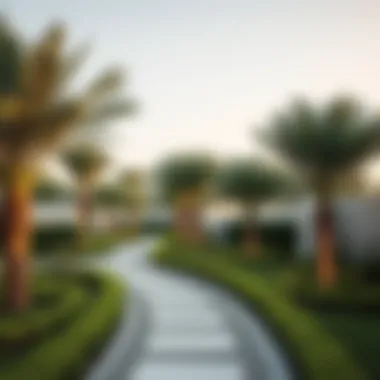
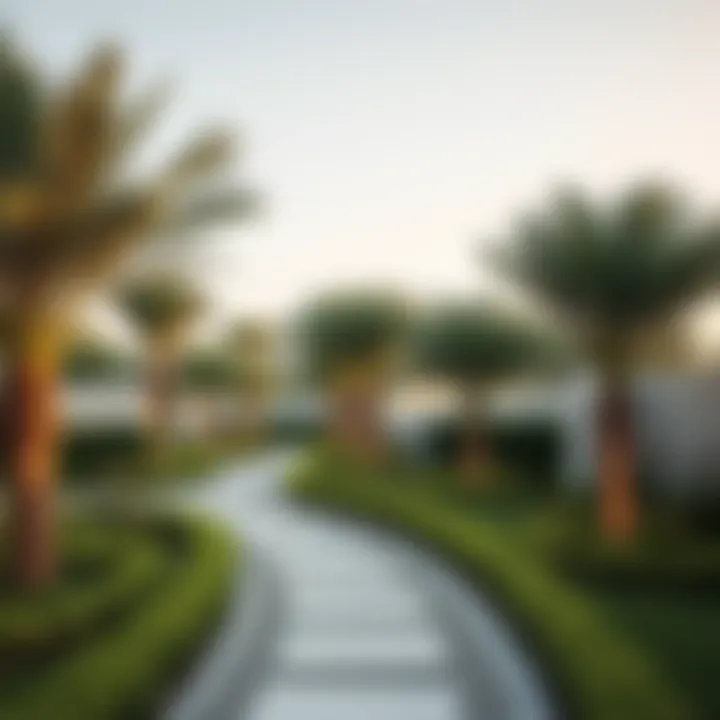
Exploring the noteworthy green garden spaces in Dubai is essential for understanding the city’s approach to integrating nature with urban living. These areas are not merely aesthetic; they serve as oases of tranquility amidst the bustling metropolis, enhancing not just the environment but also the quality of life for residents and visitors alike. They offer sanctuary, promote wellness, and support biodiversity, while often being tied to economic benefits for surrounding properties.
Dubai Miracle Garden
One of the hallmark attractions of Dubai is the Dubai Miracle Garden. This vibrant place showcases the largest natural flower garden in the world and spans over 72,000 square meters. Each spring, the garden becomes a riot of color, featuring over 150 million flowers arranged in stunning displays. Notable installations include huge floral structures such as the iconic Emirates A380 flower plane and life-sized floral castles.
Not only does the Miracle Garden provide a feast for the eyes, but it also demonstrates the efficacy of advanced irrigation systems essential for sustaining lush gardens in a desert region. Visitors regularly note the refreshing atmosphere that the garden affords, a striking contrast to the arid environment outside its boundaries. Green spaces like the Miracle Garden ultimately showcase the commitment of Dubai to embrace sustainability, encouraging the use of eco-friendly practices while also boosting tourism, an essential aspect of the emirate's economy.
The Green Planet
Next in line is The Green Planet, an indoor rainforest that offers a unique blend of education and entertainment. Located in City Walk, this biodome encapsulates an entire ecosystem, housing more than 3,000 plants and animals from all over the world. The Green Planet creates a bridge between urban life and nature, showcasing the important role of ecosystems in urban environments.
From an educational standpoint, The Green Planet emphasizes the significance of biodiversity conservation. It allows visitors to understand not just the beauty of nature, but its fragility. For investors and homebuyers, the presence of such innovative spaces increases the attractiveness of properties in the area. The additional foot traffic brought in by attractions like The Green Planet enhances local businesses, contributing positively to the overall economic landscape.
Al Barsha Pond Park
For a more laid-back vibe, Al Barsha Pond Park offers a different taste of greenery. This park is centered around a large pond, which acts as a habitat for various bird species and offers a serene environment for walking, jogging, or simply unwinding. Spanning 100 acres, the park includes cycling paths, fitness stations, and picnic areas, making it a popular choice for families and fitness enthusiasts.
The combination of lush trees, flowering plants, and well-maintained pathways makes it a haven for those seeking respite from daily routines. Moreover, local developments often thrive around parks like Al Barsha, with studies indicating a direct correlation between proximity to green spaces and increased property values. Offering scenic vistas and a plethora of recreational activities, Al Barsha Pond Park serves as a crucial element in promoting a holistic lifestyle for Dubai's residents.
"Investing in properties near vibrant green spaces can greatly enhance both lifestyle and property value, as people are gravitating towards lifestyles that prioritize wellness and nature accessibility."
Environmental Initiatives Promoting Green Spaces
The importance of promoting green spaces in urban environments cannot be understated, especially in cities like Dubai where the desert climate presents unique challenges. Initiatives aimed at increasing greenery not only enhance the aesthetic value of urban landscapes but also provide significant environmental benefits. They contribute to improved air quality, reduced heat island effects, and the promotion of biodiversity within metropolitan contexts. As urban development accelerates, integrating greenery into city planning becomes not just beneficial but essential.
Dubai's Urban Greenery Strategy
Dubai has taken measures to incorporate greenery into its urban infrastructure through its Urban Greenery Strategy. This long-term plan aims to enhance the provision of green spaces, improve the biodiversity of the area, and ensure sustainable development. The strategy involves planting trees, developing parks, and creating recreational areas that cater to the public. By boosting the overall greenery, the initiative has multiple benefits for residents and visitors alike.
- Health Benefits: Increased greenery contributes to better mental health and physical well-being for city residents.
- Biodiversity Protection: By developing new natural habitats, various species can thrive in the city.
- Carbon Sequestration: Trees absorb carbon dioxide, which helps mitigate climate change effects.
In addition, the Dubai Government promotes public participation, encouraging community involvement in greenery projects. This fosters a sense of ownership and boosts communal ties, reinforcing the social fabric of neighborhoods.
Reforestation Projects in the UAE
Complementing urban greenery efforts, the UAE has spearheaded reforestation projects to combat desertification and restore natural habitats. Various initiatives, including the UAE National Tree Campaign, advocate for the planting of native species capable of thriving in harsh climates. Native plants not only adapt well to arid conditions but also support local wildlife, creating a balanced ecosystem.
These efforts yield several advantages:
- Sustainability: Using local plant species ensures that reforestation is environmentally sound and supports local ecology.
- Economic Opportunities: Projects often engage local communities, opening avenues for job creation in the field of conservation and landscaping.
- Education and Awareness: These initiatives help raise awareness about environmental issues and the importance of sustainable practices among the populace.
"With every tree planted, we're not just combating climate change; we are nurturing our future generations' connection to nature."
Challenges of Gardening in a Desert Climate
Gardening in a desert climate like Dubai poses unique challenges. Visitors to the city might be astonished by its wealth of lush gardens, but the reality behind these green oases is a meticulous blend of creativity, technology, and relentless effort against the surrounding arid landscape. Understanding these challenges is essential for anyone looking to invest, build, or simply appreciate green spaces in this unique urban environment.
One of the primary concerns is water management. In a setting where rainfall is scarce and temperatures soar, harnessing water efficiently becomes critical. Proper irrigation systems are not just beneficial; they are essential. Moreover, urban gardeners must navigate the fluctuating water prices and potential restrictions on water use that come with managing a garden in Dubai. All these factors underscore the necessity for a well-planned approach to gardening that will allow for beautiful, sustainable spaces in an otherwise challenging environment.
Another significant issue is soil quality and nutrient management. The sandy, alkaline soil common in Dubai is notorious for its inability to retain moisture. This lack of organic matter can lead to deficiencies in essential nutrients, negatively impacting plant growth. Gardeners need to employ specific techniques for soil enrichment, such as the incorporation of compost and organic mulch. This not only aids in nutrient retention but also helps in managing the soil's temperature extremes, which could be detrimental to plant health.
"Understanding the delicate balance of water use and soil management is essential for thriving gardens in the heart of the desert."
Water Management Techniques
Water management techniques are heartbeats of successful gardening in Dubai. Traditional watering methods can result in wasted resources, given the region's climate. Utilizing modern irrigation systems provides a sustainable approach to nurture green spaces without breaking the bank on water bills.
- Drip Irrigation: A highly efficient method, drip irrigation delivers water directly to the plant roots. This minimizes evaporation rates and water runoff, making it the preferred choice for both residential and commercial gardens.
- Smart Irrigation Controllers: The advent of technology has brought smart irrigation systems that adjust based on forecasted rain and soil moisture levels. This means that plants receive just the right amount of water, enhancing efficiency.
- Rainwater Harvesting: Capturing rainwater during the rare instances of rainfall provides an alternative water source for gardens. This method not only conserves water but also reduces dependency on the municipal supply.
Soil Quality and Nutrient Management
The soil in desert environments can be deceptively challenging. To cultivate a healthy garden, the focus must shift towards enhancing the soil structure and, consequently, its nutrient content.
- Amending Soil with Organic Matter: Adding organic materials such as compost boosts microbial activity, which plays a crucial role in nutrient breakdown and availability. This process not only improves soil health but can also aid in water retention.
- Regular Testing and Monitoring: Conducting soil tests provides insight into nutrient levels and pH, allowing gardeners to tailor their approach. Regular monitoring ensures they can continuously adapt to changing conditions, a crucial strategy in a climate as unpredictable as the desert.
- Crop Rotation: Practicing crop rotation helps optimize soil nutrient levels and can combat soil depletion. Planting a diverse range of shrubs and flowers will not only create varying textures and colors but also maintain soil vitality.
In summary, navigating the challenges of gardening in a desert climate requires a blend of innovative techniques and diligent maintenance. Understanding the intricacies related to water management and soil quality is key for anyone aiming to create or invest in green spaces in Dubai.
Innovative Landscaping Solutions
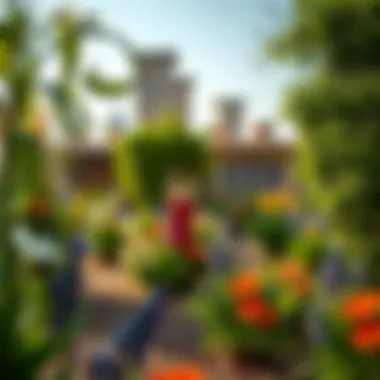
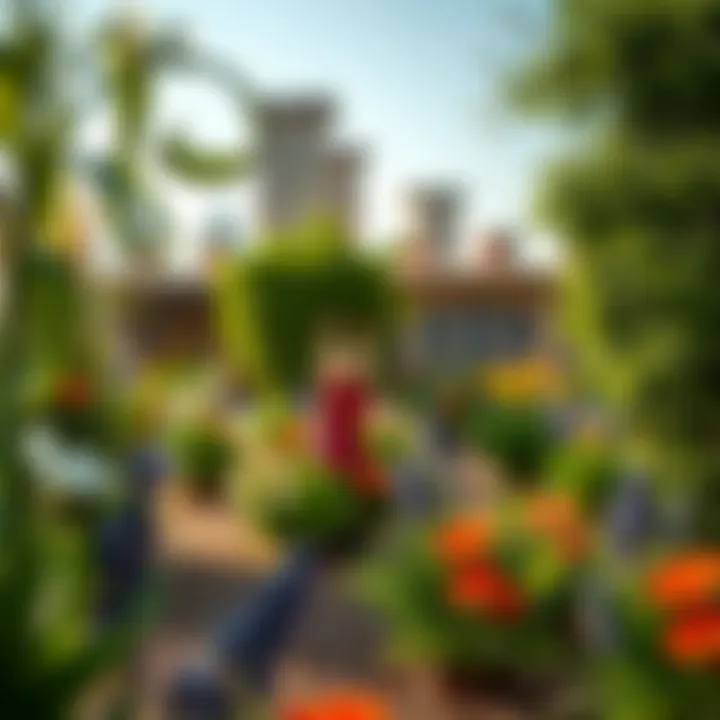
The landscape of Dubai, driven by its arid climate, makes Innovative Landscaping Solutions crucial. In a space where natural greenery is sparse, creative landscaping can totally transform urban environments into serene havens. It ensures that the cities not only look aesthetically pleasing but also function well in harmony with the surrounding desert. The importance of innovative solutions lies in their ability to maximize the use of limited water resources, enhance biodiversity, and improve air quality.
Xeriscaping in Dubai
Xeriscaping emerges as a leading solution in Dubai's gardening context. This practice revolves around designing landscapes that require minimal irrigation. Given Dubai's hot and dry climate, xeriscaping has grown into a form of art that marries functionality with beauty. Key components of xeriscaping involve selecting drought-resistant plants, using mulch to retain moisture, and planning the layout to capture rainwater.
When done right, xeriscaping can reduce water consumption significantly while still providing lush greenery. Here’s what you ought to consider when xeriscaping in Dubai:
- Plant Selection: Choosing native and adaptive plants—like the date palm or oleander—ensures resilience against the local climate.
- Soil Preparation: Enhancing the soil with organic matter increases its water retention capability, making it more suitable for drought-resistant vegetation.
- Irrigation Techniques: Utilizing drip irrigation systems ensures precise watering directly to the roots, preventing waste.
Adopting xeriscaping can substantially lower utility bills. In a society aiming for sustainability, it aligns perfectly with Dubai's vision of a greener future. This practical approach works ingeniously within both residential and commercial properties, igniting a ripple effect on water conservation efforts across the city.
Vertical Gardens and Green Walls
Vertical gardens or green walls present another innovative landscaping solution that packs a punch without consuming too much horizontal space. These installations allow for the integration of greenery into urban architecture. In Dubai, vertical gardens have become quite fashionable, sprucing up buildings and residential areas simultaneously.
Benefits of vertical gardens are multifaceted:
- Aesthetic Appeal: A green wall adds flair to any concrete structure, breaking the monotony of urban sprawl.
- Insulation: They can temper building temperatures, helping in energy conservation by reducing cooling costs.
- Air Purification: Plants actively filter toxins and dust from the air, promoting better urban air quality.
In terms of design considerations, several factors must be planned meticulously:
- Plant Types: Select species that thrive in vertical arrangements and can cope with Dubai's climate, such as ferns and succulents.
- Support Systems: Assess structural requirements to ensure walls can bear the weight of soil and water.
- Maintenance: Establish a clear maintenance routine to keep the greenery thriving without getting out of hand.
The trend for vertical gardens is on the rise, particularly among developers looking to enhance property value. Not only do they beautify spaces, but they also contribute positively to the overall environment. As communities grow, the function of these gardens is likely to expand, becoming an intrinsic part of urban design.
"Innovative landscaping solutions are not just an aesthetic choice; they are a necessity in creating sustainable urban environments in Dubai."
Such creative approaches towards gardening can cater to the needs of an evolving city like Dubai, where the blend of natural and engineered landscapes defines the urban experience.
Impact of Green Spaces on Property Value
Green spaces play a pivotal role in the landscape of urban development in Dubai, influencing property values and attracting a variety of buyers. The inherent appeal of greenery provides a stark contrast to the city’s desert backdrop, making homes surrounded by lush gardens or parks vastly more desirable. For investors and homeowners alike, understanding how green spaces influence property values is not just good to know; it’s essential.
The presence of parks and green gardens can lead to a noticeable uptick in property prices. Homes situated close to comprehensive green amenities often see their value appreciate significantly compared to those without. According to various studies, properties adjoining parks can command anywhere from 5% to 30% higher prices, depending on multiple factors such as location and accessibility.
When potential buyers stroll through a neighborhood flaunting vibrant gardens, they not only visualize their future home but also feel the serenity and fresh air that come with such environments. Green spaces provide multiple benefits, not just aesthetic ones: they foster community engagement, improve mental health, and even help with air quality. Therefore, properties with access to these spaces often stand out in the competitive real estate market of Dubai.
Market Trends Related to Green Amenities
As the real estate market in Dubai evolves, we see a growing trend where green amenities seem to boost market desirability. A 2021 report indicated that listings highlighting proximity to parks and gardens received up to 40% more inquiries than comparable properties without. This reflects a broader global movement towards sustainability—a trend that isn’t lost on Dubai’s residents. Developers are increasingly incorporating these green elements into their projects, realizing that today’s buyers are placing a premium on sustainability and aesthetic quality.
Investors, therefore, should keep a keen eye on developments integrating green technologies and landscapes. Features like community gardens, orchards, and even rooftop gardens are becoming attractive selling points. These amenities not only elevate the lifestyle experience for residents but also create a long-term investment opportunity with higher returns.
Sustainability as a Selling Point
Sustainability has firmly taken root in buyers’ minds, especially in a city like Dubai, where environmental concerns are more pronounced owing to the harsh climatic conditions. Homes that showcase sustainable practices—whether through energy-efficient designs or the incorporation of native plant species—tend to attract environmentally conscious buyers. Properties boasting solar panels, efficient irrigation systems, or even rainwater reclamation installations are now viewed as essential rather than optional luxuries.
Sustainable gardening not only lowers environmental impact but also enhances property appeal. When potential buyers learn that a property supports eco-friendly practices, their interest ramps up significantly.
- Sustainable gardens: Homes featuring xeriscaping or drought-resistant plants usually do better in terms of maintenance and cost-saving.
- Community involvement: Developments that promote community gardening initiatives often ease worries about upkeep while fostering a sense of neighborhood ownership.
Residential Green Gardens
In the heart of Dubai's urban sprawl, the concept of residential green gardens emerges as a boon for both the environment and the quality of life of its residents. The rise of these green oases can be attributed to a growing awareness of the mental and physical well-being that comes from nature. Not only do these gardens provide a breath of fresh air amid soaring skyscrapers, but they also serve as a statement of sustainability and personal touch in home design. For investors, realtors, and homebuyers, understanding the significance of these spaces can be pivotal in navigating the property landscape.
Residential gardens offer a multitude of benefits, why these are crucial to discuss include the potential for increased property value, the enhancement of community aesthetics, and the promotion of biodiversity. There is also a unique charm in having your slice of nature, be it for relaxation, gardening hobbies, or for children to play and connect with nature. Moreover, they can serve as a sanctuary in the sometimes chaotic environment that is Dubai.
Designing Your Personal Green Space
Creating a personal green space is both an art and a science. It starts with careful planning. First off, homeowners need to consider the size and orientation of their outdoor area—whether it’s a small balcony, a backyard, or a rooftop garden. This step is crucial in determining how to maximize the available space.
- Site Assessment: Think about sunlight exposure, wind patterns, and water accessibility. Understanding these elements helps in choosing the right layout.
- Statement Features: Incorporate a focal point like a water feature or an artistic garden sculpture that reflects the owner’s personality.
- Zoning: Divide the garden into functional areas. Maybe a cozy reading nook, a play area for children, and a patch for vegetables or herbs—all in one compact space.
Ultimately, aesthetics play a role, but the garden should also cater to the user’s needs—a blend of utility and beauty.
Choosing the Right Plants for Your Garden
When it comes to selecting plants for a residential garden in Dubai, it's essential to opt for varieties that can thrive in the unique desert climate. Here’s what that could look like:
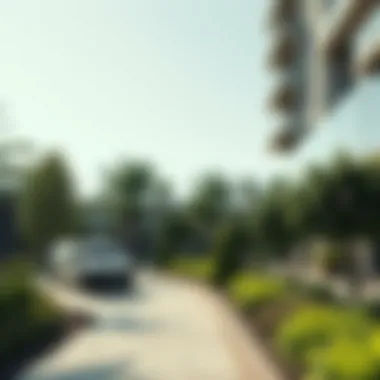
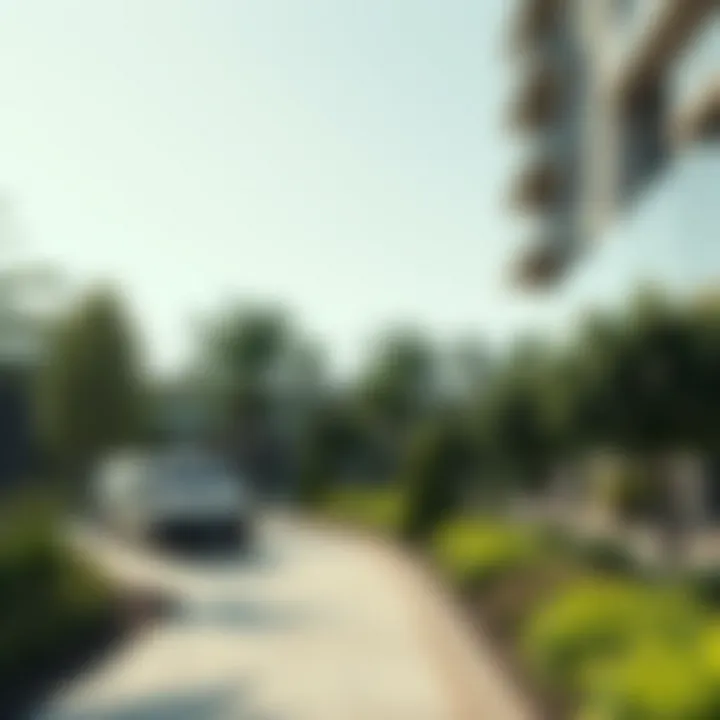
- Native Plants: These require less water and are more resilient to pests. Plants like the Ghaf tree or date palms are exemplary choices.
- Drought-Resistant Varieties: Look for succulents, cacti, and other xerophytic plants that will flourish despite the minimal rainfall.
- Edible Plants: Growing your fruits, herbs, and vegetables can be rewarding. Vegetables like tomatoes, peppers, and herbs such as basil or mint are not only delicious but also relatively easy to nurture in a home garden.
"Choosing the right plants not only brings life to the garden but also supports local fauna and contributes to the ecological balance."
Balancing aesthetic appeal and practicality when choosing plants significantly enhances the garden's value without adding undue maintenance.
In summary, residential green gardens are more than just a trend in Dubai; they represent a conscious lifestyle choice that aligns with contemporary awareness of health, environment, and community. They hold the promise of not only beautifying homes but also enriching lives. As the city continues to grow, these little pockets of nature remain vital for a sustainably enriched urban future.
For more insights on gardening in desert climates, consider checking resources from National Parks Service or Royal Horticultural Society.
Community Gardens and Urban Farming
Community gardens and urban farming are rapidly gaining traction in Dubai, reflecting a growing awareness of sustainable living in an increasingly urbanized environment. These green patches not only beautify the city but also serve as vital resources for local communities. Investing in such initiatives can transform neighborhoods and support health and well-being, making them essential for any discussion about green spaces in Dubai.
Benefits of Community Gardening
Community gardening presents a host of benefits that extend beyond mere aesthetics. Here are several key advantages:
- Enhances Social Cohesion: Community gardens foster relationships among residents, creating a sense of belonging and shared responsibility.
- Access to Fresh Produce: For many, these gardens provide an opportunity to grow fresh fruits and vegetables, contributing to improved diets and healthier lifestyles.
- Educational Opportunities: They serve as practical learning environments where both children and adults can acquire knowledge about horticulture, eco-friendly practices, and nutrition.
- Environmental Benefits: Urban gardens play a significant role in reducing the urban heat island effect, increasing biodiversity, and supporting local wildlife.
- Mental Health Improvements: Engaging with nature has been shown to reduce stress and boost overall mental health, providing respite amidst the city's hustle and bustle.
"Community gardens are a breath of fresh air in any urban setting, knitting together diverse communities and providing sustenance for both body and spirit."
These benefits make community gardens an attractive proposition for city officials, developers, and residents alike. They are much more than just a place to plant flowers; they are lifelines that nourish the community and protect the environment.
Case Studies of Successful Initiatives
Dubai offers several successful local initiatives that exemplify the potential of community gardening. Let’s delve into a few noteworthy examples:
- The Sheikh Mohammed Centre for Cultural Understanding (SMCCU): This initiative features a beautiful garden which serves as a space for cultural exchange and learning about Emirati traditions and agricultural practices.
- The Dubai Community Garden: Located in the historic Al Quoz district, this garden brings together residents from different backgrounds to cultivate fruits and vegetables.
- Green Dubai Initiative: Originally aimed at increasing greenery throughout the city, this initiative encourages community involvement in creating and maintaining green spaces, including urban farms.
- This garden not only provides fresh produce but also enhances the cultural dialogue between locals and visitors, showcasing the importance of local agriculture.
- Here, workshops on sustainable gardening techniques teach participants how to maximize space and resources, promoting self-sufficiency in urban areas.
- By integrating technology and traditional farming techniques, the project highlights innovative practices that can be adopted in arid environments.
These examples illustrate not only the practical benefits of community gardens but also their role in fostering social relationships and cultural understanding. By actively promoting and participating in such initiatives, residents contribute to a sustainable future and a vibrant urban ecosystem, enhancing the overall quality of life in Dubai.
Future of Green Spaces in Dubai
Green spaces are not just mere patches of green in a concrete jungle; they embody a vision for livable urban environments. In Dubai, as it strides into the future, the emphasis on these oases becomes paramount, both for environmental sustainability and for improving the quality of life of its residents. The future of green spaces is intricately linked to the city’s developmental blueprint, playing a significant role in addressing urban challenges while fostering a sense of community and well-being.
Predictions for Urban Development
As Dubai pushes the limits of modern architecture and urban planning, predictions regarding its green development trajectory indicate a profound shift toward more sustainable practices. Planned urban projects prioritize integrating green areas as essential components, rather than an afterthought. Based on current trends, several critical elements stand out:
- Increased Green Coverage: Initiatives like the Dubai Urban Forestry Strategy aim to plant millions of trees throughout the city, establishing a refreshing canopy for both residents and wildlife. Plans for expanding parks or creating new green corridors aim to connect different areas, enhancing biodiversity.
- Smart Urban Design: The nearness of technology and nature will be paramount. Urban developments will incorporate features like rain gardens and bioswales that naturally filter stormwater. Mixed-use developments may integrate green spaces that serve both recreational needs and environmental functions—think of a park that offers a space for outdoor yoga and wildlife habitats.
- Civic Participation: More than just government-led efforts, there’s a growing recognition of the need for communities to participate in gardening initiatives. Local voices will likely be heard to shape how spaces evolve, and citizen-led projects will sprout to address specific community challenges and preferences.
Role of Technology in Gardening
With technology blossoming like never before, the modern gardener in Dubai faces a promising landscape. The fusion of tech with nature embodies the path to overcoming the unique challenges posed by the desert climate. Here are some examples of how technology is set to revolutionize gardening in Dubai:
- Smart Irrigation Systems: Modern irrigation technologies, such as drip systems coupled with soil moisture sensors, allow gardens to minimize water waste. This precision in watering not only conserves water but ensures plants receive optimal hydration without the headache of oversaturation.
- Urban Farming Innovations: Hydroponics and vertical farming have become burgeoning trends here. These soil-less cultivation techniques can be adapted to urban environments where space is limited. This allows for sustainable food production right alongside urban dwellers, reducing the need for transportation.
- Mobile Applications: There’s a growing number of apps dedicated to gardening tasks, from identifying plant species to diagnosing plant diseases and recommending appropriate solutions. Such platforms could empower novice and seasoned gardeners alike by providing real-time data and insights.
"The intersection of technology and green spaces is not merely a trend; it marks a fundamental shift in how urban ecology is perceived".
As Dubai continues on this ambitious path, the vision for its green spaces remains bright, characterized by innovation, community engagement, and a commitment to sustainable growth. Not only will these green endeavors shape the landscape, but they will also hold the key to fostering a healthier and more connected urban ecosystem.
Ending
In wrapping up the discussion on green gardens in Dubai, it becomes glaringly clear that such spaces are not simply aesthetic embellishments but essential components of the city’s urban landscape. The emphasis on greenery in a desert environment addresses various pressing issues while enhancing the quality of life for residents and visitors alike.
Key Elements to Consider
- Environmental Benefits: Green gardens play a crucial role in reducing heat, lowering air pollution, and improving overall biodiversity. These areas serve as habitats for various species, creating an ecological balance.
- Social Connectivity: Community gardens foster social ties and promote a sense of belonging among residents. They encourage collaboration and shared experiences, making them vital for community building.
- Economic Viability: For investors, the integration of green spaces—such as parks and gardens—can significantly raise property values. Properties adjacent to lush environments often see increased demand, highlighting the direct link between greenery and market trends. Realtors frequently note that homes with extensive green features are more appealing, thus driving up prices.
Considerations for Future Development
- As Dubai continues to evolve with ambitious urban development plans, it’s essential for developers to integrate nature into their designs. The sustainability of the city hinges on responsible planning that incorporates green solutions.
- Homebuyers should take note; a property set amidst landscaped gardens or near public parks not only offers leisure and relaxation but also represents a prudent investment in today’s competitive real estate market.
“A city thrives when its green spaces flourish, drawing in people and investment, while providing a breath of fresh air in a bustling environment.”
For more insight into urban gardening and its benefits, explore resources like Wikipedia, Britannica, and discussions on platforms like Reddit.
Let us encourage the ongoing transformation of Dubai into a greener haven, one garden at a time.
